View in other NatureServe Network Field Guides
NatureServe
Montana
Utah
Wyoming
Idaho
Wisconsin
British Columbia
South Carolina
Yukon
California
New York
Gillette's Checkerspot - Euphydryas gillettii
General Description
[From Ferris and Brown 1981; Scott 1986; Glassberg 2001; Pyle 2002] Forewing 2.0-2.5 cm. Upperwings predominantly black on the basal 2/3, with red and white spot-bands, a distinctive orange-red submarginal band across the predominately dark-brown to black wings; underwings with alternating bands of cream and bright brick-red with black veins and borders of spot-bands.
Phenology
One flight; mostly late June to July (late July to mid-August for subalpine sites), with a short flight season (Scott 1986; Glassberg 2001); mid-June to late July in British Columbia (Guppy and Shepard 2001); June to mid-August (Williams et al. 1984).
Diagnostic Characteristics
The orange-red submarginal band across the predominately dark-brown to black forewings and hindwings is distinctive.
Species Range
Montana Range
Range Descriptions
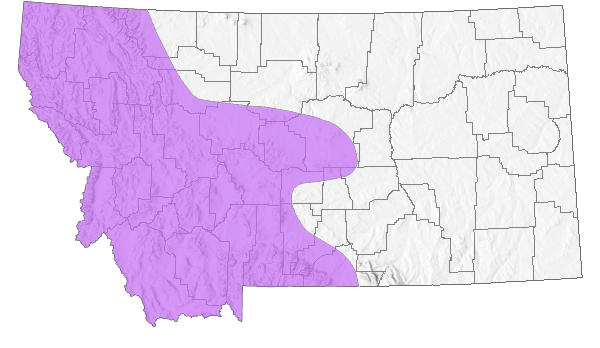
 Native
Native
Range Comments
In the Rocky Mountains, from southern Alberta and extreme eastern British Columbia south through northern Idaho, western Montana and western Wyoming (Ferris and Brown 1981; Scott 1986; Williams 1988; Glassberg 2001); between 975-2620m elevation. In Montana, reported from most counties in the western (mountainous) third of the state (Kohler 1980; Stanford and Opler 1993); between 975-2225 m elevation. Locally rare (Glassberg 2001).
Observations in Montana Natural Heritage Program Database
Number of Observations: 39
(Click on the following maps and charts to see full sized version)
Map Help and Descriptions
Relative Density
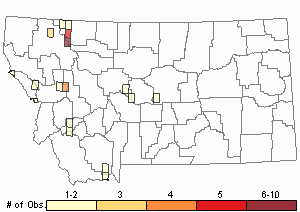
Recency
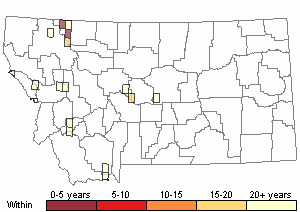

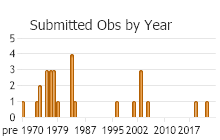
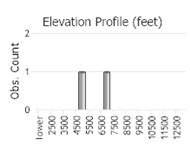 (Observations spanning multiple months or years are excluded from time charts)
(Observations spanning multiple months or years are excluded from time charts)
Migration
Non-migratory.
Habitat
Montane areas in wet meadows, marshy sites, along small streams, open riparian habitat; tree canopy predominantly lodgepole pine, Engelmann spruce, subalpine fir, sometimes with willow, cottonwood, aspen, often in fire-disturbed locations (Williams et al. 1984; Scott 1986; Williams 1988, 1995; Guppy and Shepard 2001). Habitat in Montana as described above (Williams 1988); in Glacier National Park, reported in montane mesic meadows and woodlands (Debinski 1993).
National Vegetation Classification System Groups Associated with this Species
Forest and Woodland
Deciduous Forest and Woodland
Montane - Subalpine Forest and Woodland
Shrubland
Foothills - Montane Shrubland
Grassland
Lowland - Prairie Grassland
Montane - Subalpine Grassland
Wetland and Riparian
Alpine Riparian and Wetland
Peatland
Riparian and Wetland Forest
Riparian Shrubland
Wet Meadow and Marsh
Recently Disturbed or Modified
Recently Burned
Food Habits
Larval food plants predominantly Lonicera involucrata and to a lesser extent Valeriana occidentalis (Williams et al. 1984; Williams and Bowers 1987). Oviposition reported on other plant species, including Castilleja, Pedicularis, Symphoricarpus, and Veronica; larvae feed on Plantago in captivity (Scott 1986; Williams 1988). Adults feed on flower nectar (including Achillia, Agoseris, Antennaria, Arnica, Aster, Chrysanthemum, Cirsium, Geranium, Geum, Helianthella, Heracleum, Polygonum, Potentilla, Rosa, Saxifraga, Senecio, Solidago, Valeriana) and mud (Williams 1988, 1995; Scott 2014).
Reproductive Characteristics
Females lay eggs in masses on the undersides of host plant green leaves that tend to intercept morning sun; Wyoming masses in the Beartooth Mountains average 146 eggs (23-310 eggs), masses in the Teton Mountains average 130 eggs. Egg loss from masses ranges from 13-30%. Eggs hatch from July to September, 23-45 days after laying. Newly emerged larvae shortly migrate to the upper surface of leaves where they form a communal feeding web and remain together overwinter. Diapause (overwintering) can occur in L2-L4 instars, depending on duration prior to onset of winter. Larvae terminate diapause shortly after spring snow melt (late May to mid-June); most larvae diapause a second winter as L5 before pupating. L5 instars move away from host plants and pupate within 50 cm of the ground; pupation to adult emergence requires about 21 days (Williams 1981; Williams et al. 1984). Males patrol near conifer tree tops in search of females, and mating typically occurs in or near the tops of trees.
Stewardship Responsibility
References
- Literature Cited AboveLegend:
 View Online Publication
View Online Publication Debinski, D. 1993. Butterflies of Glacier National Park, Montana. Occasional Papers of the Museum of Natural History, the University of Kansas, Lawrence, Kansas. No. 159: 1-13.
Debinski, D. 1993. Butterflies of Glacier National Park, Montana. Occasional Papers of the Museum of Natural History, the University of Kansas, Lawrence, Kansas. No. 159: 1-13. Ferris, C.D. and F.M. Brown (eds). 1981. Butterflies of the Rocky Mountains. Univ. of Oklahoma Press. Norman. 442 pp.
Ferris, C.D. and F.M. Brown (eds). 1981. Butterflies of the Rocky Mountains. Univ. of Oklahoma Press. Norman. 442 pp. Glassberg, J. 2001. Butterflies through Binoculars: A Field Guide to the Butterflies of Western North America. Oxford University Press.
Glassberg, J. 2001. Butterflies through Binoculars: A Field Guide to the Butterflies of Western North America. Oxford University Press. Guppy, C.S. and J.H. Shepard. 2001. Butterflies of British Columbia: including western Alberta, southern Yukon, the Alaska Panhandle, Washington, northern Oregon, northern Idaho, northwestern Montana. UBC Press (Vancouver, BC) and Royal British Columbia Museum (Victoria, BC). 414 pp.
Guppy, C.S. and J.H. Shepard. 2001. Butterflies of British Columbia: including western Alberta, southern Yukon, the Alaska Panhandle, Washington, northern Oregon, northern Idaho, northwestern Montana. UBC Press (Vancouver, BC) and Royal British Columbia Museum (Victoria, BC). 414 pp. Kohler, S. 1980. Checklist of Montana Butterflies (Rhopalocera). Journal of the Lepidopterists' Society 34(1): 1-19.
Kohler, S. 1980. Checklist of Montana Butterflies (Rhopalocera). Journal of the Lepidopterists' Society 34(1): 1-19. Pyle, R.M. 2002. The butterflies of Cascadia: a field guide to all the species of Washington, Oregon, and surrounding territories. Seattle Audubon Society, Seattle, Washington. 420 pp.
Pyle, R.M. 2002. The butterflies of Cascadia: a field guide to all the species of Washington, Oregon, and surrounding territories. Seattle Audubon Society, Seattle, Washington. 420 pp. Scott, J.A. 1986. The butterflies of North America: a natural history and field guide. Stanford University Press, Stanford, California.
Scott, J.A. 1986. The butterflies of North America: a natural history and field guide. Stanford University Press, Stanford, California. Scott, J.A. 2014. Lepidoptera of North America 13. Flower visitation by Colorado butterflies (40,615 records) with a review of the literature on pollination of Colorado plants and butterfly attraction (Lepidoptera: Hersperioidea and Papilionoidea). Contributions of the C.P. Gillette Museum of Arthopod Diversity. Fort Collins, CO: Colorado State University. 190 p.
Scott, J.A. 2014. Lepidoptera of North America 13. Flower visitation by Colorado butterflies (40,615 records) with a review of the literature on pollination of Colorado plants and butterfly attraction (Lepidoptera: Hersperioidea and Papilionoidea). Contributions of the C.P. Gillette Museum of Arthopod Diversity. Fort Collins, CO: Colorado State University. 190 p. Stanford, R.E. and P.A. Opler. 1993. Atlas of western USA butterflies: including adjacent parts of Canada and Mexico. Unpubl. Report. Denver and Fort Collins, Colorado 275 pp.
Stanford, R.E. and P.A. Opler. 1993. Atlas of western USA butterflies: including adjacent parts of Canada and Mexico. Unpubl. Report. Denver and Fort Collins, Colorado 275 pp. Williams, E.H. 1981. Thermal influences on oviposition in the montane butterfly Euphydryas gillettii. Oecologia 50(3): 342-346.
Williams, E.H. 1981. Thermal influences on oviposition in the montane butterfly Euphydryas gillettii. Oecologia 50(3): 342-346. Williams, E.H. 1988. Habitat and range of Euphydryas gillettii (Nymphalidae). Journal of the Lepidopterists' Society 42(1): 37-45.
Williams, E.H. 1988. Habitat and range of Euphydryas gillettii (Nymphalidae). Journal of the Lepidopterists' Society 42(1): 37-45. Williams, E.H. 1995. Fire-Burned Habitat and Reintroduction of the Butterfly Euphydryas Gillettii (Nymphalidae). Journal of the Lepidopterists' Society 49: 183-191.
Williams, E.H. 1995. Fire-Burned Habitat and Reintroduction of the Butterfly Euphydryas Gillettii (Nymphalidae). Journal of the Lepidopterists' Society 49: 183-191. Williams, E.H. and M.D. Bowers. 1987. Factors Affecting Host Plant Use by the Montane Butterfly Euphydryas Gillettii (Nymphalidae). American Midland Naturalist 118(1): 153-161.
Williams, E.H. and M.D. Bowers. 1987. Factors Affecting Host Plant Use by the Montane Butterfly Euphydryas Gillettii (Nymphalidae). American Midland Naturalist 118(1): 153-161. Williams, E.H., C.E. Holdren, and P.R. Ehrlich. 1984. The Life History and Ecology of Euphydryas Gillettii Barnes (Nymphalidae). Journal of the Lepidopterists' Society 38(1): 1-12.
Williams, E.H., C.E. Holdren, and P.R. Ehrlich. 1984. The Life History and Ecology of Euphydryas Gillettii Barnes (Nymphalidae). Journal of the Lepidopterists' Society 38(1): 1-12.
- Additional ReferencesLegend:
 View Online Publication
View Online Publication
Do you know of a citation we're missing? Allen, T.J., J.P. Brock, and J. Glassberg. 2005. Caterpillars in the field and garden: a field guide to the butterfly caterpillars of North America. Oxford University Press.
Allen, T.J., J.P. Brock, and J. Glassberg. 2005. Caterpillars in the field and garden: a field guide to the butterfly caterpillars of North America. Oxford University Press. Brock, J.P. and K. Kaufman. 2003. Kaufman Field Guide to Butterflies of North America. Houghton Mifflin Company, New York, NY 284 pp.
Brock, J.P. and K. Kaufman. 2003. Kaufman Field Guide to Butterflies of North America. Houghton Mifflin Company, New York, NY 284 pp. Caruthers, J.C., and D. Debinski. 2006. Montane meadow butterfly species distributions in the Greater Yellowstone Ecosystem. University of Wyoming National Park Service Research Center Annual Report, 2006. Vol. 30, Art. 14. 85-96.
Caruthers, J.C., and D. Debinski. 2006. Montane meadow butterfly species distributions in the Greater Yellowstone Ecosystem. University of Wyoming National Park Service Research Center Annual Report, 2006. Vol. 30, Art. 14. 85-96. Debinski, D. M. 1991. Inventory and monitoring of biodiversity: an assessment of methods and a case study of Glacier National Park, MT. Ph.D. Dissertation. Montana State University, Bozeman. 205 p.
Debinski, D. M. 1991. Inventory and monitoring of biodiversity: an assessment of methods and a case study of Glacier National Park, MT. Ph.D. Dissertation. Montana State University, Bozeman. 205 p. Forister, M.L., C.A. Halsch, C.C. Nice, J.A. Fordyce, T.E. Dilts, J.C. Oliver, K.L. Prudic, A.M. Shapiro, J.K. Wilson, J. Glassberg. 2021. Fewer butterflies seen by community scientists across the warming and drying landscapes of the American West. Science 371:1042-1045.
Forister, M.L., C.A. Halsch, C.C. Nice, J.A. Fordyce, T.E. Dilts, J.C. Oliver, K.L. Prudic, A.M. Shapiro, J.K. Wilson, J. Glassberg. 2021. Fewer butterflies seen by community scientists across the warming and drying landscapes of the American West. Science 371:1042-1045. Forister, M.L., E.M. Grames, C.A. Halsch, K.J. Burls, C.F. Carroll, K.L. Bell, J.P. Jahner, et al. 2023. Assessing risk for butterflies in the context of climate change, demographic uncertainty, and heterogeneous data sources. Ecological Monographs 93(3):e1584. https://doi.org/10.1002/ecm.1584
Forister, M.L., E.M. Grames, C.A. Halsch, K.J. Burls, C.F. Carroll, K.L. Bell, J.P. Jahner, et al. 2023. Assessing risk for butterflies in the context of climate change, demographic uncertainty, and heterogeneous data sources. Ecological Monographs 93(3):e1584. https://doi.org/10.1002/ecm.1584 Layberry, R.A., P.W. Hall, and J.D. LaFontaine. 1998. The Butterflies of Canada. University of Toronto Press. 280 pp. + color plates.
Layberry, R.A., P.W. Hall, and J.D. LaFontaine. 1998. The Butterflies of Canada. University of Toronto Press. 280 pp. + color plates. Opler, P.A. and A.B. Wright. 1999. A field guide to western butterflies. Second edition. Peterson Field Guides. Houghton Mifflin Company, Boston, Massachusetts. 540 pp.
Opler, P.A. and A.B. Wright. 1999. A field guide to western butterflies. Second edition. Peterson Field Guides. Houghton Mifflin Company, Boston, Massachusetts. 540 pp.
- Web Search Engines for Articles on "Gillette's Checkerspot"
- Additional Sources of Information Related to "Insects"





